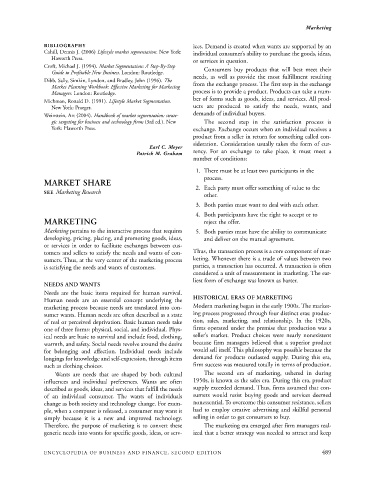Page 512 - Encyclopedia of Business and Finance
P. 512
eobf_M 7/5/06 3:15 PM Page 489
Marketing
BIBLIOGRAPHY ices. Demand is created when wants are supported by an
Cahill, Dennis J. (2006) Lifestyle market segmentation. New York: individual consumer’s ability to purchase the goods, ideas,
Haworth Press.
or services in question.
Croft, Michael J. (1994). Market Segmentation: A Step-By-Step Consumers buy products that will best meet their
Guide to Profitable New Business. London: Routledge.
needs, as well as provide the most fulfillment resulting
Dibb, Sally, Simkin, Lyndon, and Bradley, John (1996). The
Market Planning Workbook: Effective Marketing for Marketing from the exchange process. The first step in the exchange
Managers. London: Routledge. process is to provide a product. Products can take a num-
ber of forms such as goods, ideas, and services. All prod-
Michman, Ronald D. (1991). Lifestyle Market Segmentation.
New York: Praeger. ucts are produced to satisfy the needs, wants, and
demands of individual buyers.
Weinstein, Art (2004). Handbook of market segmentation: strate-
gic targeting for business and technology firms (3rd ed.). New The second step in the satisfaction process is
York: Haworth Press. exchange. Exchange occurs when an individual receives a
product from a seller in return for something called con-
sideration. Consideration usually takes the form of cur-
Earl C. Meyer
Patrick M. Graham rency. For an exchange to take place, it must meet a
number of conditions:
1. There must be at least two participants in the
process.
MARKET SHARE
2. Each party must offer something of value to the
SEE Marketing Research
other.
3. Both parties must want to deal with each other.
4. Both participants have the right to accept or to
MARKETING reject the offer.
Marketing pertains to the interactive process that requires 5. Both parties must have the ability to communicate
developing, pricing, placing, and promoting goods, ideas, and deliver on the mutual agreement.
or services in order to facilitate exchanges between cus-
tomers and sellers to satisfy the needs and wants of con- Thus, the transaction process is a core component of mar-
sumers. Thus, at the very center of the marketing process keting. Whenever there is a trade of values between two
is satisfying the needs and wants of customers. parties, a transaction has occurred. A transaction is often
considered a unit of measurement in marketing. The ear-
liest form of exchange was known as barter.
NEEDS AND WANTS
Needs are the basic items required for human survival.
HISTORICAL ERAS OF MARKETING
Human needs are an essential concept underlying the
marketing process because needs are translated into con- Modern marketing began in the early 1900s. The market-
sumer wants. Human needs are often described as a state ing process progressed through four distinct eras: produc-
of real or perceived deprivation. Basic human needs take tion, sales, marketing, and relationship. In the 1920s,
one of three forms: physical, social, and individual. Phys- firms operated under the premise that production was a
ical needs are basic to survival and include food, clothing, seller’s market. Product choices were nearly nonexistent
warmth, and safety. Social needs revolve around the desire because firm managers believed that a superior product
for belonging and affection. Individual needs include would sell itself. This philosophy was possible because the
longings for knowledge and self-expression, through items demand for products outlasted supply. During this era,
such as clothing choices. firm success was measured totally in terms of production.
Wants are needs that are shaped by both cultural The second era of marketing, ushered in during
influences and individual preferences. Wants are often 1950s, is known as the sales era. During this era, product
described as goods, ideas, and services that fulfill the needs supply exceeded demand. Thus, firms assumed that con-
of an individual consumer. The wants of individuals sumers would resist buying goods and services deemed
change as both society and technology change. For exam- nonessential. To overcome this consumer resistance, sellers
ple, when a computer is released, a consumer may want it had to employ creative advertising and skillful personal
simply because it is a new and improved technology. selling in order to get consumers to buy.
Therefore, the purpose of marketing is to convert these The marketing era emerged after firm managers real-
generic needs into wants for specific goods, ideas, or serv- ized that a better strategy was needed to attract and keep
ENCYCLOPEDIA OF BUSINESS AND FINANCE, SECOND EDITION 489

